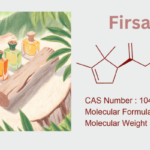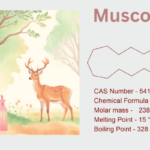Few molecules have established a unique niche for themselves in the complex dance of perfumery, where science and art meet. Cashmeran is one such molecule. This synthetic musk, which is well-known for having a soft, velvety perfume that is reminiscent of cashmere wool, has emerged as a key component of contemporary fragrance design. Beyond its sensory appeal, there is a story of chemical creativity at work—a tale of how industrial ingenuity and molecular architecture created a fragrance that unites the physical and the otherworldly. This article explores the chemistry of cashmeran, including its synthesis, worldwide manufacturing, and revolutionary position in perfumery. It also looks at the difficulties and prospects facing this iconic scent.
1. The Molecular Essence: Decoding Cashmeran’s Structure
Cashmeran is a member of the polycyclic musk family and is chemically recognized as 6,7-Dihydro-1,1,2,3,3-pentamethyl-4(5H)-indanone (C₁₅H₂₆O). Features of its structure:
- A bicyclic indanone core, providing thermal and oxidative stability.
- Methyl groups at strategic positions, enhancing volatility and diffusion.
- A ketone functional group, pivotal for its interaction with olfactory receptors.
With a powdery softness that evokes the tactile luxury of cashmere cloth, Cashmeran’s smell profile is subtle, woody, musky, and slightly amber-like thanks to its small, stiff structure. Cashmeran is a perfumer’s ally since, in contrast to musks originating from animals, its synthetic nature guarantees ethical manufacture and batch uniformity.
2. Synthesis of Cashmeran: Crafting Complexity in the Lab
A masterwork in organic chemistry, the synthesis of cashmeran uses hydrogenation and cycloaddition to put its complex structure together. Here is a detailed explanation:
Step 1: Diels-Alder Reaction
The trip starts with a Diels-Alder reaction between methyl acrylate and the terpene myrcene. The bicyclic skeleton of the molecule is established via this [4+2] cycloaddition, which creates a six-membered cyclohexene derivative.
Step 2: Hydrogenation
Palladium or nickel catalysts are used to catalytically hydrogenate the cyclohexene intermediate. Double bonds are saturated as a result, changing the structure into a stable decalin system.
Step 3: Cyclization and Methylation
When cyclization is catalyzed by acid, the molecule folds into the indanone core. Pentamethyl groups, which are essential to Cashmeran’s olfactory characteristics, are introduced by further methylation with methyl chloride.
Step 4: Purification
Through vacuum distillation and crystallization, the crude product is refined to a purity of >98%. Toluene and other residual solvents are carefully eliminated in accordance with International Fragrance Association (IFRA) regulations.
3. Sources of Cashmeran: Global Production and Key Players
The titans of the fragrance industry control the manufacturing of cashmeran, which is entirely synthetic:
- Firmenich (Switzerland): a pioneer in the synthesis of musk, possessing important patents for the efficient manufacturing of Cashmeran.
- Givaudan (Switzerland): makes use of continuous-flow reactors to cut waste and increase yield.
- Symrise (Germany): focuses on green chemistry by using citrus trash to produce bio-based myrcene.
Geographic Hotspots:
- Europe: leads in the production of luxury perfumes using high-purity cashmeran.
- Asia: China and India concentrate on producing mass-market cosmetics at a reasonable cost.
Raw-Materials:
Myrcene, traditionally derived from petrochemicals, is increasingly sourced from terpenes in pine or citrus oils, aligning with sustainability goals.
4. Perfume Formulation: Cashmeran’s Olfactory Alchemy
Cashmeran is a versatile fixative and middle note due to its warm, creamy, and diffusive fragrance character. Important uses consist of:
Fragrance Roles:
- Base Note Enhancer: Extends the longevity of citrus and floral top notes.
- Texture Modifier: gives oriental and woody accords a smooth depth.
Iconic Uses:
- Calvin Klein’s Obsession: The sensuous amber base of the scent is supported by the muskiness of cashmeran.
- Maison Margiela’s By the Fireplace: Enhances smoky, chestnut-like warmth.
- Functional Products: Candles and body lotions take advantage of its skin-safe durability.
IFRA Guidelines:
Due to sensitization concerns, cashmeran is limited to 2.5% in leave-on cosmetics, forcing perfumers to strike a compromise between innovation and legality.
5. Challenges: Balancing Performance and Responsibility
- Environmental Persistence: Cashmeran, a polycyclic musk found in aquatic environments, is resistant to biodegradation. Thorough environmental impact assessments are required under the EU’s REACH law.
- Synthetic Byproducts: Advanced analytics (GC-MS, HPLC) are required because trace contaminants, such as isocashmeran, might change smell characteristics.
- Supply Chain Vulnerabilities: Myrcene’s reliance on petrochemicals presents difficulties in light of changing energy regulations.
Case Study: The significance of quality control was highlighted in 2019 when a European producer conducted a batch recall and linked off-notes to insufficient hydrogenation.
6. Innovations and Future Directions
The industry is reimagining Cashmeran’s synthesis and application:
Green Chemistry:
- Bio-Based Myrcene: Carbon footprints are decreased by using engineered yeast strains to manufacture terpenes from sugarcane.
- Enzymatic Cyclization: Lipases replace harsh acids, minimizing waste.
Advanced Delivery Systems:
- Microencapsulation: Cashmeran particles covered with polymers allow for time-release in smart fabrics.
- AI-Driven Formulation: The best blends for target smell profiles are predicted by machine learning.
Regulatory Adaptation:
The goal of chemists and perfumers working together is to create cashmeran derivatives that are more biodegradable without sacrificing fragrance.
7. Conclusion: The Scent of Innovation
The evolution of Cashmeran from a 1970s lab experiment to a mainstay in perfumery is a perfect example of how molecular design and sensory artistry may work together. It gave perfumers a weapon of unmatched variety while resolving the moral dilemmas surrounding animal musks. Cashmeran’s development, driven by innovative technology and green chemistry, will continue to influence the olfactory landscape as the fragrance industry makes significant progress toward sustainability.
“Perfume is the art of making memory speak,” as renowned perfumer Jean-Claude Ellena once said. Those memories are certain to endure, encased in the imperceptible embrace of science, thanks to Cashmeran’s chemical accuracy and emotional warmth.










